Cardinal Health Inc. Financial Analysis Report in Healthcare Finance
VerifiedAdded on 2022/08/23
|10
|1495
|21
Report
AI Summary
This report offers a financial analysis of Cardinal Health Inc., a major healthcare services company. It begins with an introduction and then delves into a financial analysis using ratio analysis, covering profitability (gross profit margin, operating profit margin, return on equity, return on total assets), liquidity (current ratio), efficiency (accounts receivable), and solvency ratios (debt-equity ratio). The analysis examines the company's performance in 2018 and 2019, highlighting areas for improvement, such as increasing sales to boost profit margins and improving the return on equity. The report also discusses good revenue cycle and accounts management, and concludes with the creation of an action plan to minimize health disparities and maximize service levels, including strategies to achieve these goals. References to relevant sources are included. The report provides valuable insights into Cardinal Health's financial health and strategic planning.
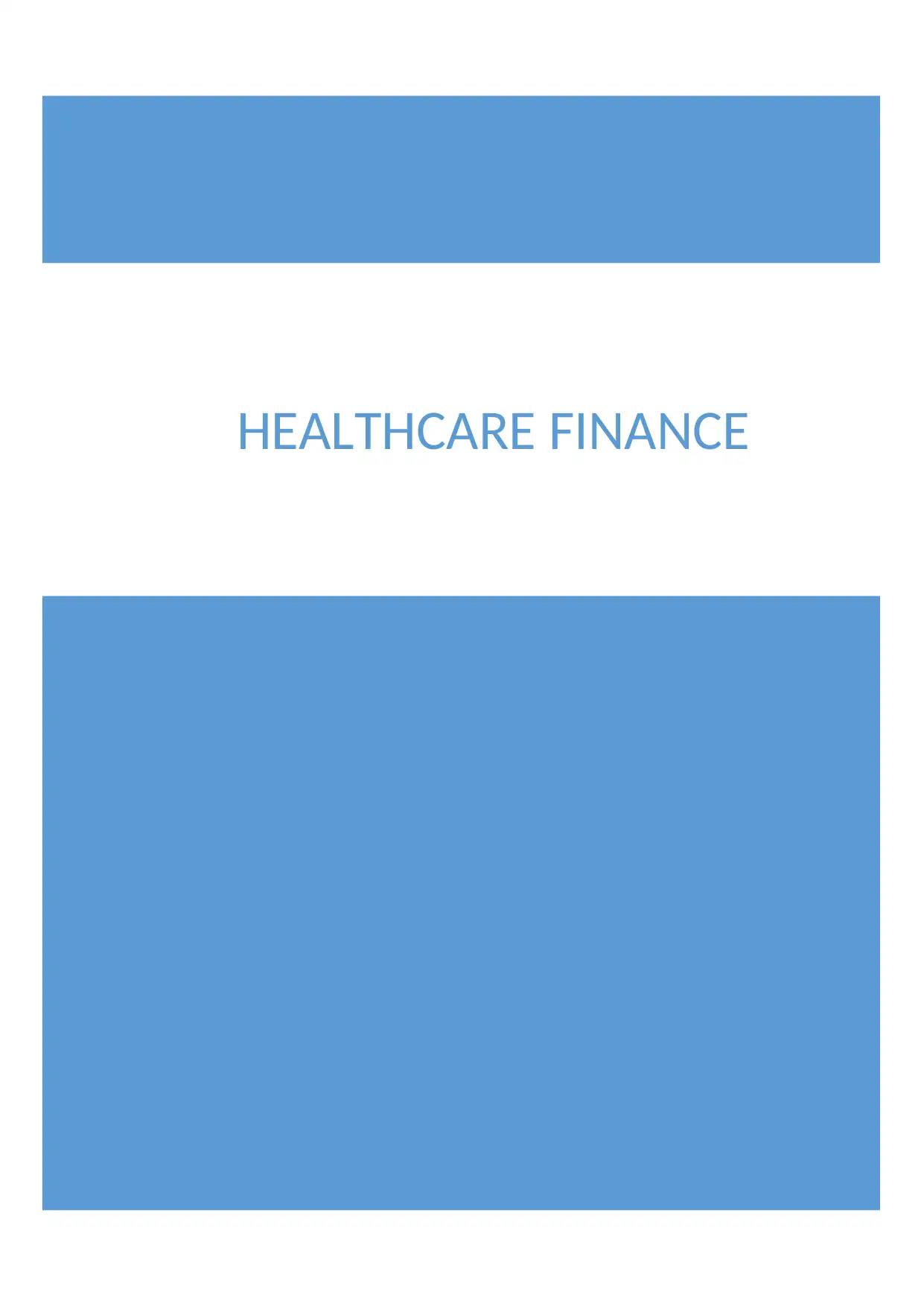
HEALTHCARE FINANCE
Paraphrase This Document
Need a fresh take? Get an instant paraphrase of this document with our AI Paraphraser
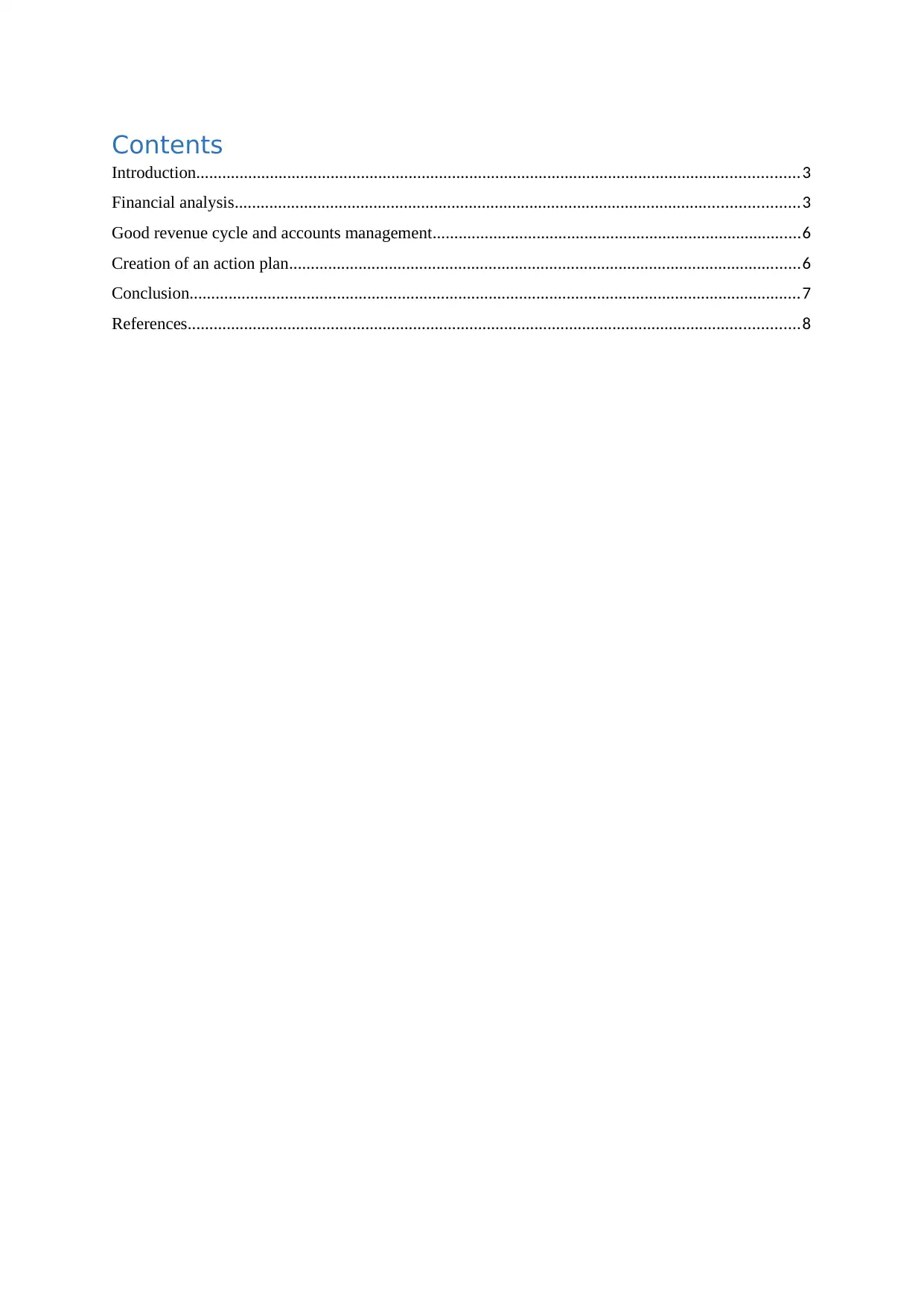
Contents
Introduction...........................................................................................................................................3
Financial analysis..................................................................................................................................3
Good revenue cycle and accounts management.....................................................................................6
Creation of an action plan......................................................................................................................6
Conclusion.............................................................................................................................................7
References.............................................................................................................................................8
Introduction...........................................................................................................................................3
Financial analysis..................................................................................................................................3
Good revenue cycle and accounts management.....................................................................................6
Creation of an action plan......................................................................................................................6
Conclusion.............................................................................................................................................7
References.............................................................................................................................................8
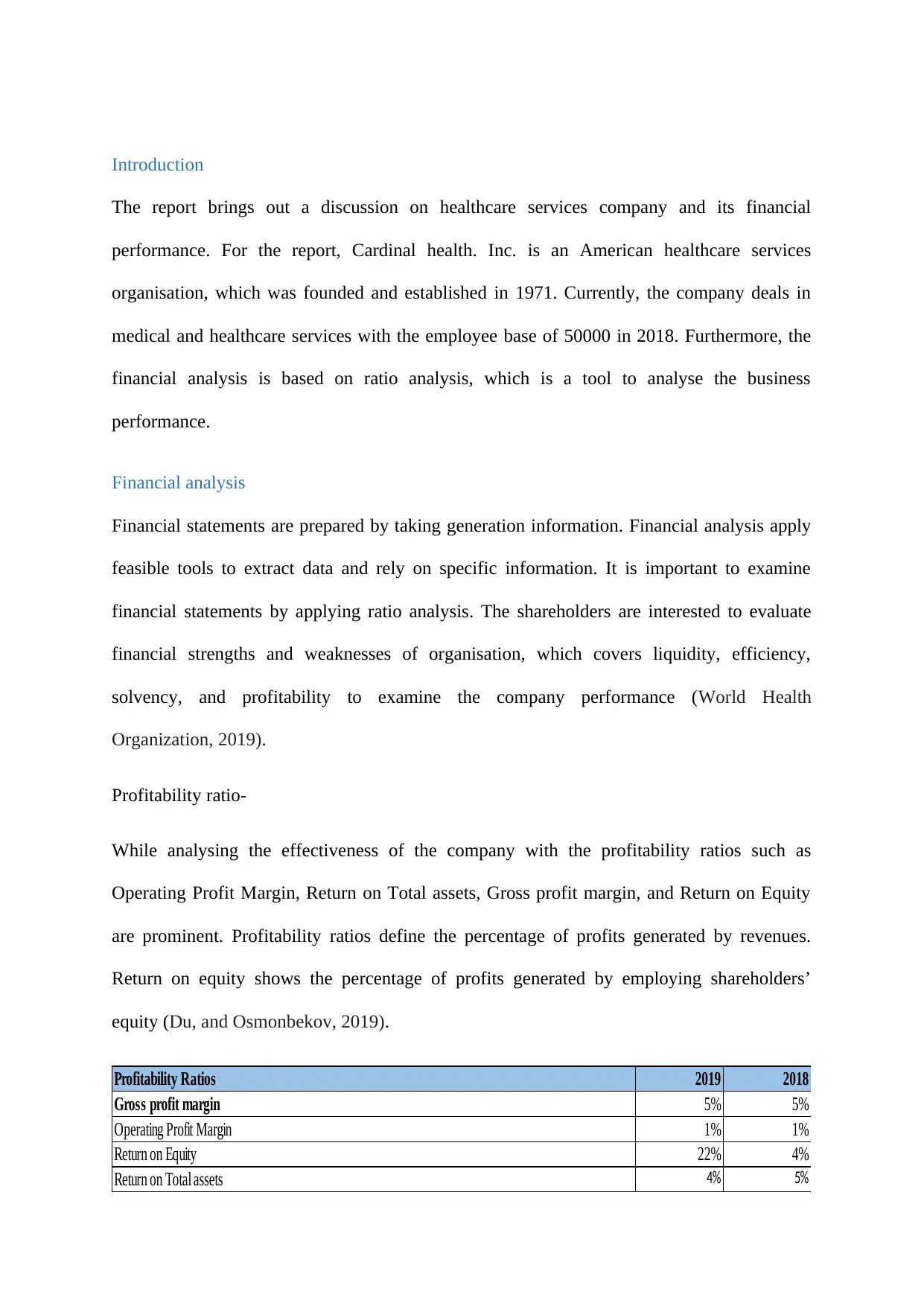
Introduction
The report brings out a discussion on healthcare services company and its financial
performance. For the report, Cardinal health. Inc. is an American healthcare services
organisation, which was founded and established in 1971. Currently, the company deals in
medical and healthcare services with the employee base of 50000 in 2018. Furthermore, the
financial analysis is based on ratio analysis, which is a tool to analyse the business
performance.
Financial analysis
Financial statements are prepared by taking generation information. Financial analysis apply
feasible tools to extract data and rely on specific information. It is important to examine
financial statements by applying ratio analysis. The shareholders are interested to evaluate
financial strengths and weaknesses of organisation, which covers liquidity, efficiency,
solvency, and profitability to examine the company performance (World Health
Organization, 2019).
Profitability ratio-
While analysing the effectiveness of the company with the profitability ratios such as
Operating Profit Margin, Return on Total assets, Gross profit margin, and Return on Equity
are prominent. Profitability ratios define the percentage of profits generated by revenues.
Return on equity shows the percentage of profits generated by employing shareholders’
equity (Du, and Osmonbekov, 2019).
Profitability Ratios 2019 2018
Gross profit margin 5% 5%
Operating Profit Margin 1% 1%
Return on Equity 22% 4%
Return on Total assets 4% 5%
The report brings out a discussion on healthcare services company and its financial
performance. For the report, Cardinal health. Inc. is an American healthcare services
organisation, which was founded and established in 1971. Currently, the company deals in
medical and healthcare services with the employee base of 50000 in 2018. Furthermore, the
financial analysis is based on ratio analysis, which is a tool to analyse the business
performance.
Financial analysis
Financial statements are prepared by taking generation information. Financial analysis apply
feasible tools to extract data and rely on specific information. It is important to examine
financial statements by applying ratio analysis. The shareholders are interested to evaluate
financial strengths and weaknesses of organisation, which covers liquidity, efficiency,
solvency, and profitability to examine the company performance (World Health
Organization, 2019).
Profitability ratio-
While analysing the effectiveness of the company with the profitability ratios such as
Operating Profit Margin, Return on Total assets, Gross profit margin, and Return on Equity
are prominent. Profitability ratios define the percentage of profits generated by revenues.
Return on equity shows the percentage of profits generated by employing shareholders’
equity (Du, and Osmonbekov, 2019).
Profitability Ratios 2019 2018
Gross profit margin 5% 5%
Operating Profit Margin 1% 1%
Return on Equity 22% 4%
Return on Total assets 4% 5%
⊘ This is a preview!⊘
Do you want full access?
Subscribe today to unlock all pages.

Trusted by 1+ million students worldwide

From the above table, it is seen that the company had earned gross profit ratio of 5 percent in
2018 and 2019. The standard ratio for profitability is 15-20 percent. Operating margin is 1
percent for both the years. The profits of the company quite less because of increasing direct
and indirect costs. Therefore, in order to improve profit ratios, the company has to increase
their sales, which will lead to increase in profitability (Jochemsen, and Koole, 2018).
In 2019, the company has earned proportion of 22 percent as return on equity and in 2018;
Cardinal health generates return on equity as 4 percent. The decreasing return on equity
means that company is less efficient in creating profits and also increasing shareholder
values. In order to calculate ROE, the formula is EBIT to average total assets (Jochemsen,
and Koole, 2018). There is a greater need to enhance the return on equity by maintaining
appropriate financial leverage (combination of debt and equity). Increasing profit margins,
which indicates the organisation’s higher yield on equity, distributing the idle cash, lowering
the taxes, and enhancing the asset turnover (Zhang, and Weatherford, 2017, 25).
Return on total assets is the proportion of net profit generated by employing total assets.
Cardinal Health Company generates a return of 5 percent in 2018 and 4 percent in 2019
(Kunnumkal, and Talluri, 2019).
Liquidity ratio-
The ratio specifies whether the business is capable enough to pay off its current
responsibilities with the help of its current assets. The most prominent ratio to measure the
liquidity position is current ratio.
Liquidity ratio 2019 2018
Current ratio 1.07 1.07
The ideal ratio for current ratio is 2:1, which indicates that the company is able to maintain
two times of current assets to pay off one proportion of current liabilities (Zimmermann,
2018 and 2019. The standard ratio for profitability is 15-20 percent. Operating margin is 1
percent for both the years. The profits of the company quite less because of increasing direct
and indirect costs. Therefore, in order to improve profit ratios, the company has to increase
their sales, which will lead to increase in profitability (Jochemsen, and Koole, 2018).
In 2019, the company has earned proportion of 22 percent as return on equity and in 2018;
Cardinal health generates return on equity as 4 percent. The decreasing return on equity
means that company is less efficient in creating profits and also increasing shareholder
values. In order to calculate ROE, the formula is EBIT to average total assets (Jochemsen,
and Koole, 2018). There is a greater need to enhance the return on equity by maintaining
appropriate financial leverage (combination of debt and equity). Increasing profit margins,
which indicates the organisation’s higher yield on equity, distributing the idle cash, lowering
the taxes, and enhancing the asset turnover (Zhang, and Weatherford, 2017, 25).
Return on total assets is the proportion of net profit generated by employing total assets.
Cardinal Health Company generates a return of 5 percent in 2018 and 4 percent in 2019
(Kunnumkal, and Talluri, 2019).
Liquidity ratio-
The ratio specifies whether the business is capable enough to pay off its current
responsibilities with the help of its current assets. The most prominent ratio to measure the
liquidity position is current ratio.
Liquidity ratio 2019 2018
Current ratio 1.07 1.07
The ideal ratio for current ratio is 2:1, which indicates that the company is able to maintain
two times of current assets to pay off one proportion of current liabilities (Zimmermann,
Paraphrase This Document
Need a fresh take? Get an instant paraphrase of this document with our AI Paraphraser
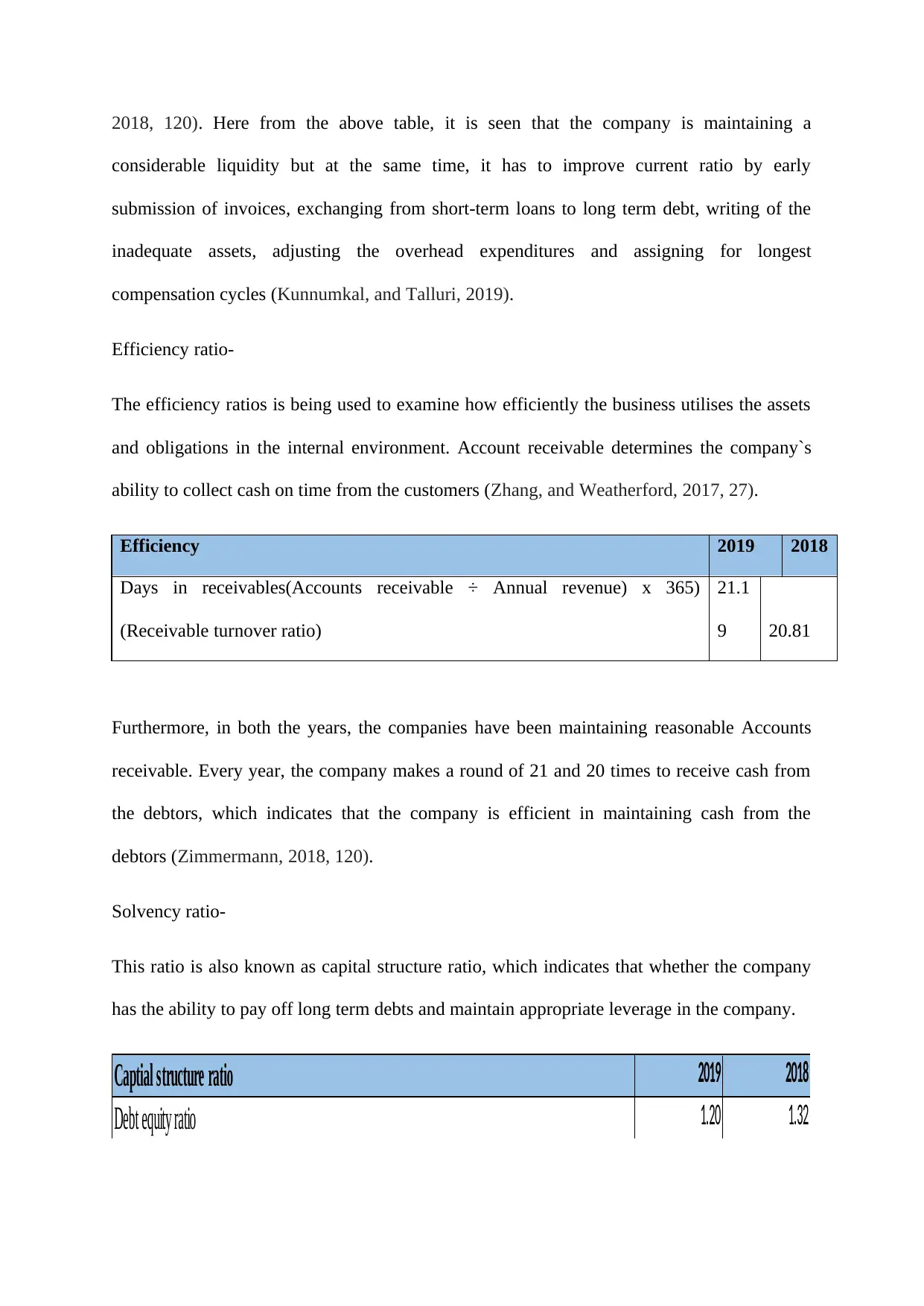
2018, 120). Here from the above table, it is seen that the company is maintaining a
considerable liquidity but at the same time, it has to improve current ratio by early
submission of invoices, exchanging from short-term loans to long term debt, writing of the
inadequate assets, adjusting the overhead expenditures and assigning for longest
compensation cycles (Kunnumkal, and Talluri, 2019).
Efficiency ratio-
The efficiency ratios is being used to examine how efficiently the business utilises the assets
and obligations in the internal environment. Account receivable determines the company`s
ability to collect cash on time from the customers (Zhang, and Weatherford, 2017, 27).
Efficiency 2019 2018
Days in receivables(Accounts receivable ÷ Annual revenue) x 365)
(Receivable turnover ratio)
21.1
9 20.81
Furthermore, in both the years, the companies have been maintaining reasonable Accounts
receivable. Every year, the company makes a round of 21 and 20 times to receive cash from
the debtors, which indicates that the company is efficient in maintaining cash from the
debtors (Zimmermann, 2018, 120).
Solvency ratio-
This ratio is also known as capital structure ratio, which indicates that whether the company
has the ability to pay off long term debts and maintain appropriate leverage in the company.
Captial structure ratio 2019 2018
Debt equity ratio 1.20 1.32
considerable liquidity but at the same time, it has to improve current ratio by early
submission of invoices, exchanging from short-term loans to long term debt, writing of the
inadequate assets, adjusting the overhead expenditures and assigning for longest
compensation cycles (Kunnumkal, and Talluri, 2019).
Efficiency ratio-
The efficiency ratios is being used to examine how efficiently the business utilises the assets
and obligations in the internal environment. Account receivable determines the company`s
ability to collect cash on time from the customers (Zhang, and Weatherford, 2017, 27).
Efficiency 2019 2018
Days in receivables(Accounts receivable ÷ Annual revenue) x 365)
(Receivable turnover ratio)
21.1
9 20.81
Furthermore, in both the years, the companies have been maintaining reasonable Accounts
receivable. Every year, the company makes a round of 21 and 20 times to receive cash from
the debtors, which indicates that the company is efficient in maintaining cash from the
debtors (Zimmermann, 2018, 120).
Solvency ratio-
This ratio is also known as capital structure ratio, which indicates that whether the company
has the ability to pay off long term debts and maintain appropriate leverage in the company.
Captial structure ratio 2019 2018
Debt equity ratio 1.20 1.32
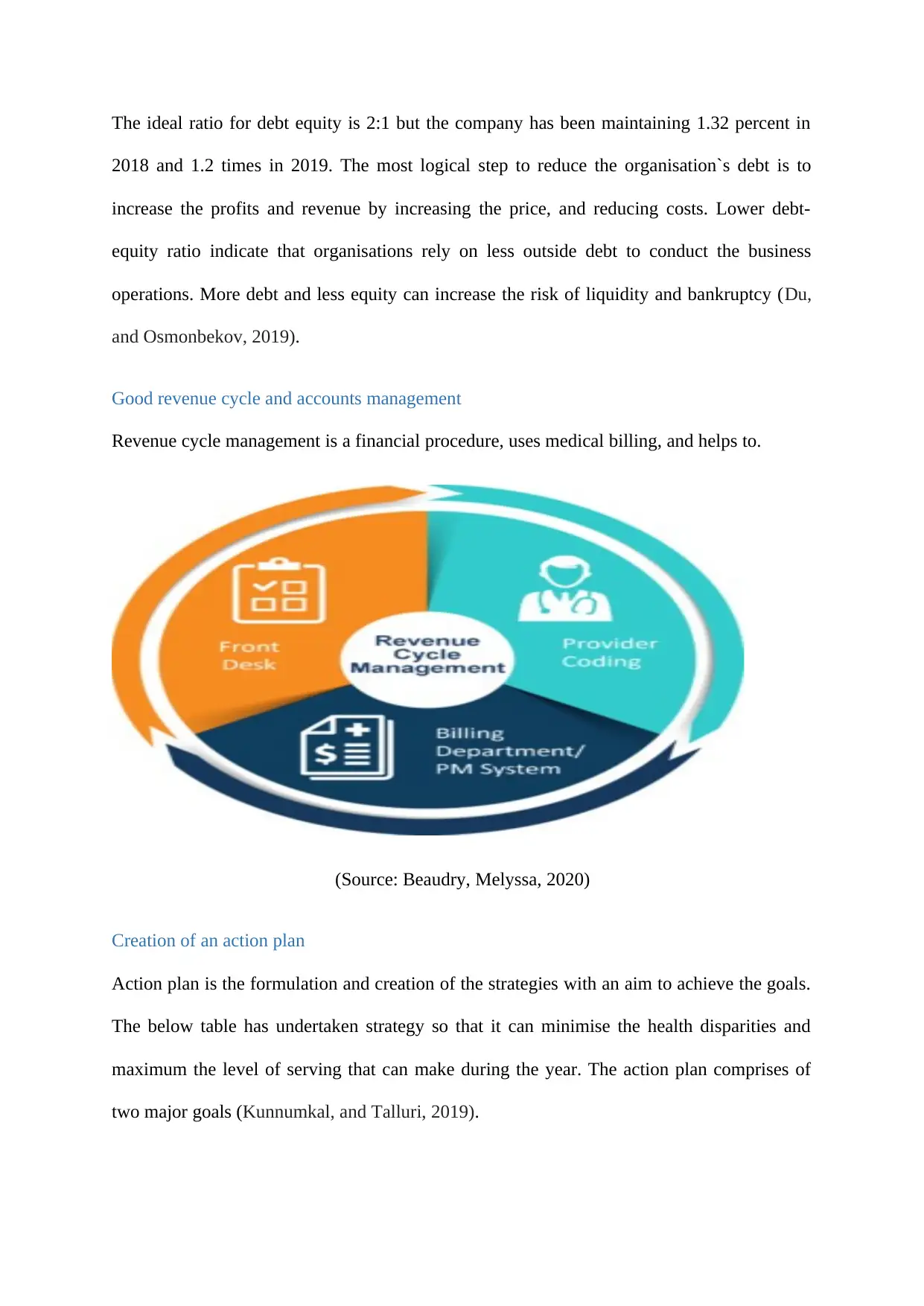
The ideal ratio for debt equity is 2:1 but the company has been maintaining 1.32 percent in
2018 and 1.2 times in 2019. The most logical step to reduce the organisation`s debt is to
increase the profits and revenue by increasing the price, and reducing costs. Lower debt-
equity ratio indicate that organisations rely on less outside debt to conduct the business
operations. More debt and less equity can increase the risk of liquidity and bankruptcy (Du,
and Osmonbekov, 2019).
Good revenue cycle and accounts management
Revenue cycle management is a financial procedure, uses medical billing, and helps to.
(Source: Beaudry, Melyssa, 2020)
Creation of an action plan
Action plan is the formulation and creation of the strategies with an aim to achieve the goals.
The below table has undertaken strategy so that it can minimise the health disparities and
maximum the level of serving that can make during the year. The action plan comprises of
two major goals (Kunnumkal, and Talluri, 2019).
2018 and 1.2 times in 2019. The most logical step to reduce the organisation`s debt is to
increase the profits and revenue by increasing the price, and reducing costs. Lower debt-
equity ratio indicate that organisations rely on less outside debt to conduct the business
operations. More debt and less equity can increase the risk of liquidity and bankruptcy (Du,
and Osmonbekov, 2019).
Good revenue cycle and accounts management
Revenue cycle management is a financial procedure, uses medical billing, and helps to.
(Source: Beaudry, Melyssa, 2020)
Creation of an action plan
Action plan is the formulation and creation of the strategies with an aim to achieve the goals.
The below table has undertaken strategy so that it can minimise the health disparities and
maximum the level of serving that can make during the year. The action plan comprises of
two major goals (Kunnumkal, and Talluri, 2019).
⊘ This is a preview!⊘
Do you want full access?
Subscribe today to unlock all pages.

Trusted by 1+ million students worldwide
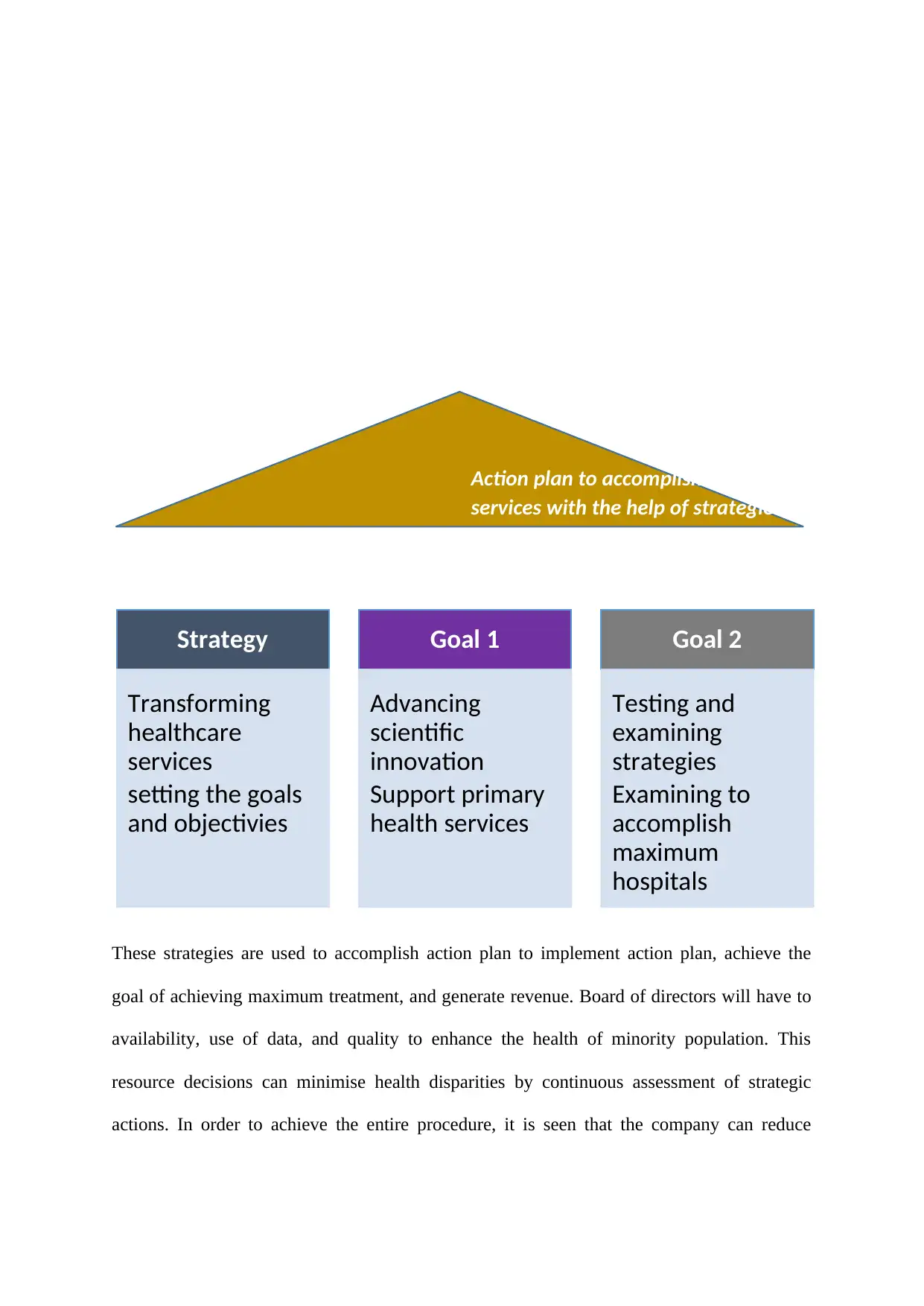
These strategies are used to accomplish action plan to implement action plan, achieve the
goal of achieving maximum treatment, and generate revenue. Board of directors will have to
availability, use of data, and quality to enhance the health of minority population. This
resource decisions can minimise health disparities by continuous assessment of strategic
actions. In order to achieve the entire procedure, it is seen that the company can reduce
Strategy
Transforming
healthcare
services
setting the goals
and objectivies
Goal 1
Advancing
scientific
innovation
Support primary
health services
Goal 2
Testing and
examining
strategies
Examining to
accomplish
maximum
hospitals
Action plan to accomplish several
services with the help of strategies
strategicsteragoalsgo goals
goal of achieving maximum treatment, and generate revenue. Board of directors will have to
availability, use of data, and quality to enhance the health of minority population. This
resource decisions can minimise health disparities by continuous assessment of strategic
actions. In order to achieve the entire procedure, it is seen that the company can reduce
Strategy
Transforming
healthcare
services
setting the goals
and objectivies
Goal 1
Advancing
scientific
innovation
Support primary
health services
Goal 2
Testing and
examining
strategies
Examining to
accomplish
maximum
hospitals
Action plan to accomplish several
services with the help of strategies
strategicsteragoalsgo goals
Paraphrase This Document
Need a fresh take? Get an instant paraphrase of this document with our AI Paraphraser
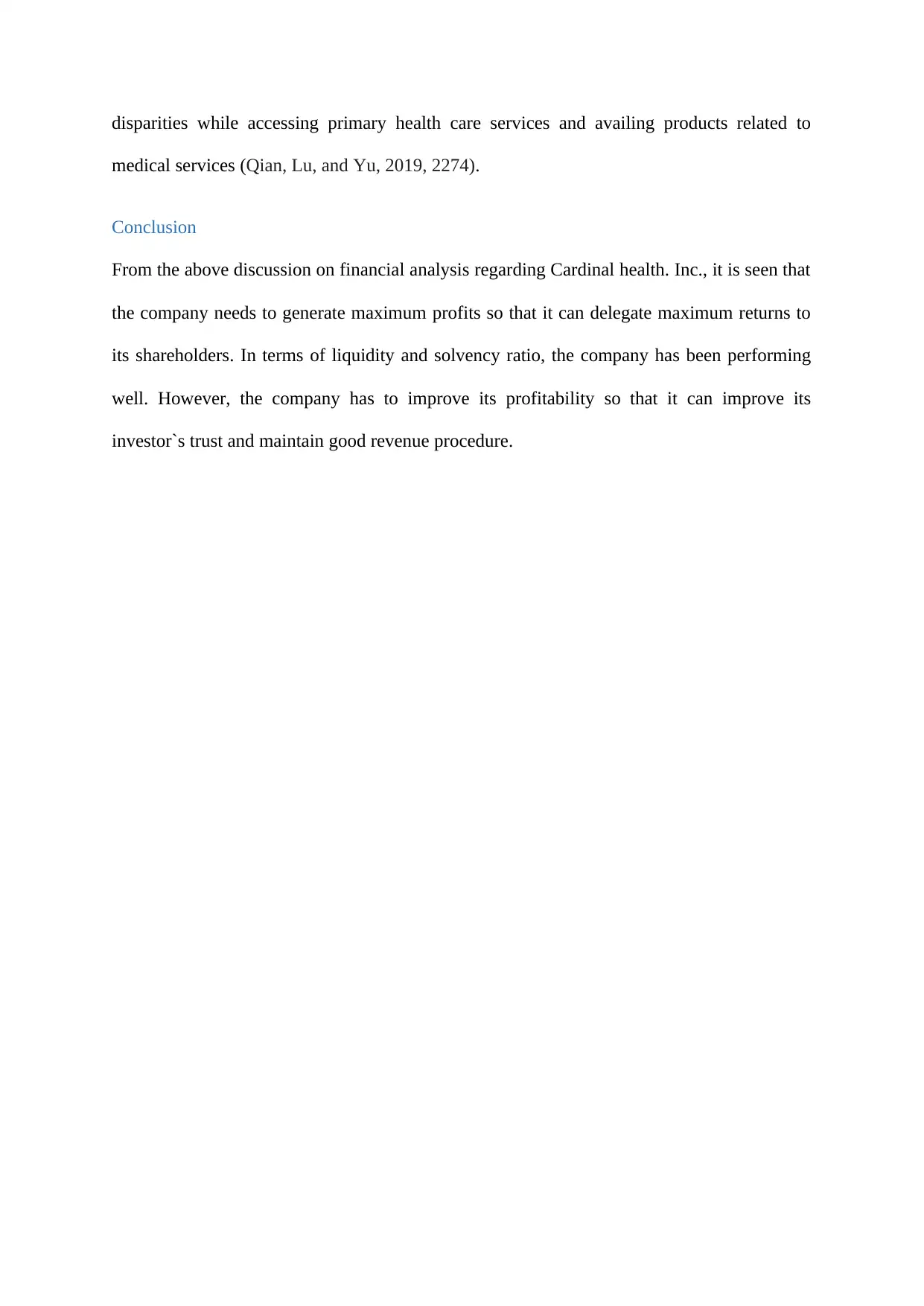
disparities while accessing primary health care services and availing products related to
medical services (Qian, Lu, and Yu, 2019, 2274).
Conclusion
From the above discussion on financial analysis regarding Cardinal health. Inc., it is seen that
the company needs to generate maximum profits so that it can delegate maximum returns to
its shareholders. In terms of liquidity and solvency ratio, the company has been performing
well. However, the company has to improve its profitability so that it can improve its
investor`s trust and maintain good revenue procedure.
medical services (Qian, Lu, and Yu, 2019, 2274).
Conclusion
From the above discussion on financial analysis regarding Cardinal health. Inc., it is seen that
the company needs to generate maximum profits so that it can delegate maximum returns to
its shareholders. In terms of liquidity and solvency ratio, the company has been performing
well. However, the company has to improve its profitability so that it can improve its
investor`s trust and maintain good revenue procedure.

References
Beaudry, Melyssa “Bigger than Billing… Exploring the Nuances of True Revenue Cycle
Management”. March 17, 2020. https://www.gopmg.com/blog/bigger-than-billing-
exploring-the-nuances-of-true-revenue-cycle-management/
Qian, C., Lu, L.Y. and Yu, Y., 2019. Financial analyst coverage and corporate social
performance: Evidence from natural experiments. Strategic Management Journal, 40(13),
pp.2271-2286.
Du, D. and Osmonbekov, T., 2019. Direct effect of advertising spending on firm value:
Moderating role of financial analyst coverage. International Journal of Research in
Marketing.
Kunnumkal, S. and Talluri, K., 2019. Choice Network Revenue Management Based on New
Tractable Approximations. Transportation Science, 53(6), pp.1591-1608.
Zimmermann, A., 2018, May. Revenue Management Information Systems for Small and
Medium-Sized Hotels: Empirical Insights into the Current Situation in Germany.
In Intelligent Decision Technologies 2018: Proceedings of the 10th KES International
Conference on Intelligent Decision Technologies (KES-IDT 2018) (Vol. 97, p. 120). Springer.
Zhang, D. and Weatherford, L., 2017. Dynamic pricing for network revenue management: A
new approach and application in the hotel industry. INFORMS Journal on Computing, 29(1),
pp.18-35.
Jochemsen, T. and Koole, G., 2018. Comparison of theory and practice of revenue
management with undifferentiated demand.
World Health Organization, 2019. Global action plan on physical activity 2018-2030: more
active people for a healthier world. World Health Organization.
Beaudry, Melyssa “Bigger than Billing… Exploring the Nuances of True Revenue Cycle
Management”. March 17, 2020. https://www.gopmg.com/blog/bigger-than-billing-
exploring-the-nuances-of-true-revenue-cycle-management/
Qian, C., Lu, L.Y. and Yu, Y., 2019. Financial analyst coverage and corporate social
performance: Evidence from natural experiments. Strategic Management Journal, 40(13),
pp.2271-2286.
Du, D. and Osmonbekov, T., 2019. Direct effect of advertising spending on firm value:
Moderating role of financial analyst coverage. International Journal of Research in
Marketing.
Kunnumkal, S. and Talluri, K., 2019. Choice Network Revenue Management Based on New
Tractable Approximations. Transportation Science, 53(6), pp.1591-1608.
Zimmermann, A., 2018, May. Revenue Management Information Systems for Small and
Medium-Sized Hotels: Empirical Insights into the Current Situation in Germany.
In Intelligent Decision Technologies 2018: Proceedings of the 10th KES International
Conference on Intelligent Decision Technologies (KES-IDT 2018) (Vol. 97, p. 120). Springer.
Zhang, D. and Weatherford, L., 2017. Dynamic pricing for network revenue management: A
new approach and application in the hotel industry. INFORMS Journal on Computing, 29(1),
pp.18-35.
Jochemsen, T. and Koole, G., 2018. Comparison of theory and practice of revenue
management with undifferentiated demand.
World Health Organization, 2019. Global action plan on physical activity 2018-2030: more
active people for a healthier world. World Health Organization.
⊘ This is a preview!⊘
Do you want full access?
Subscribe today to unlock all pages.

Trusted by 1+ million students worldwide

1 out of 10
Related Documents
Your All-in-One AI-Powered Toolkit for Academic Success.
+13062052269
info@desklib.com
Available 24*7 on WhatsApp / Email
![[object Object]](/_next/static/media/star-bottom.7253800d.svg)
Unlock your academic potential
Copyright © 2020–2025 A2Z Services. All Rights Reserved. Developed and managed by ZUCOL.





